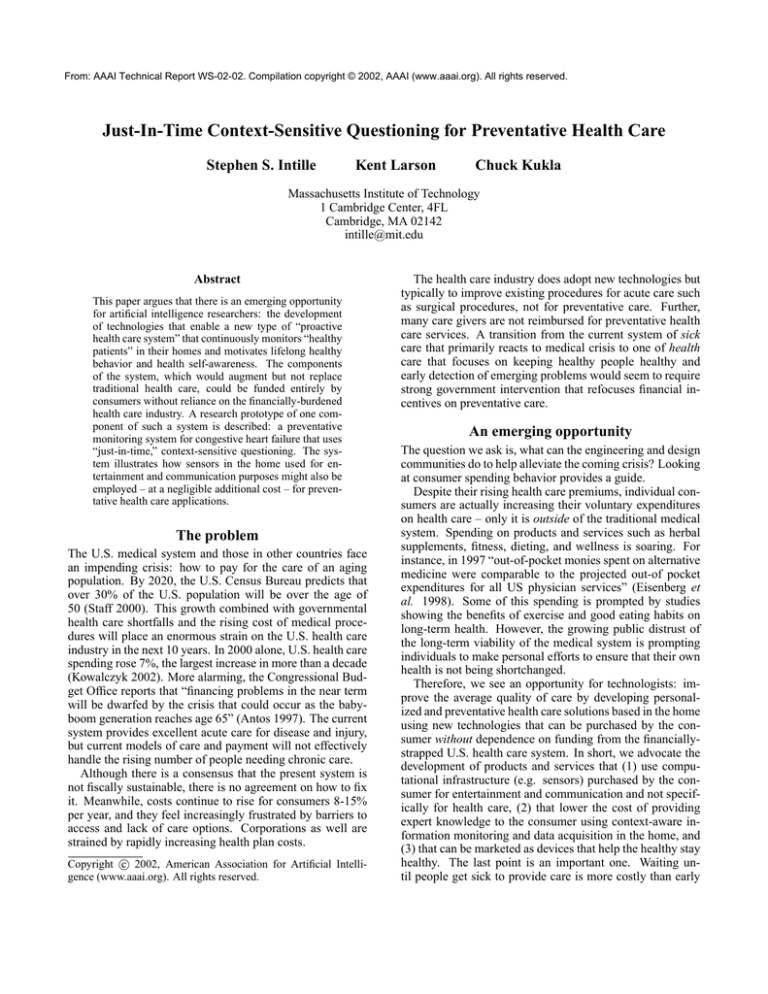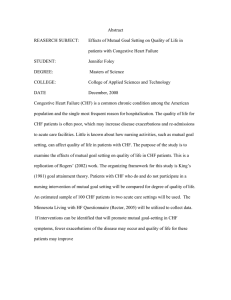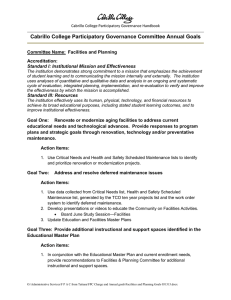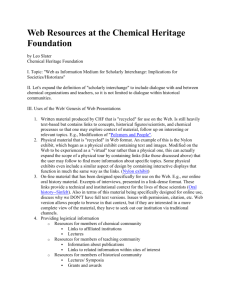
From: AAAI Technical Report WS-02-02. Compilation copyright © 2002, AAAI (www.aaai.org). All rights reserved.
Just-In-Time Context-Sensitive Questioning for Preventative Health Care
Stephen S. Intille
Kent Larson
Chuck Kukla
Massachusetts Institute of Technology
1 Cambridge Center, 4FL
Cambridge, MA 02142
intille@mit.edu
Abstract
This paper argues that there is an emerging opportunity
for artificial intelligence researchers: the development
of technologies that enable a new type of “proactive
health care system” that continuously monitors “healthy
patients” in their homes and motivates lifelong healthy
behavior and health self-awareness. The components
of the system, which would augment but not replace
traditional health care, could be funded entirely by
consumers without reliance on the financially-burdened
health care industry. A research prototype of one component of such a system is described: a preventative
monitoring system for congestive heart failure that uses
“just-in-time,” context-sensitive questioning. The system illustrates how sensors in the home used for entertainment and communication purposes might also be
employed – at a negligible additional cost – for preventative health care applications.
The problem
The U.S. medical system and those in other countries face
an impending crisis: how to pay for the care of an aging
population. By 2020, the U.S. Census Bureau predicts that
over 30% of the U.S. population will be over the age of
50 (Staff 2000). This growth combined with governmental
health care shortfalls and the rising cost of medical procedures will place an enormous strain on the U.S. health care
industry in the next 10 years. In 2000 alone, U.S. health care
spending rose 7%, the largest increase in more than a decade
(Kowalczyk 2002). More alarming, the Congressional Budget Office reports that “financing problems in the near term
will be dwarfed by the crisis that could occur as the babyboom generation reaches age 65” (Antos 1997). The current
system provides excellent acute care for disease and injury,
but current models of care and payment will not effectively
handle the rising number of people needing chronic care.
Although there is a consensus that the present system is
not fiscally sustainable, there is no agreement on how to fix
it. Meanwhile, costs continue to rise for consumers 8-15%
per year, and they feel increasingly frustrated by barriers to
access and lack of care options. Corporations as well are
strained by rapidly increasing health plan costs.
c 2002, American Association for Artificial IntelliCopyright gence (www.aaai.org). All rights reserved.
The health care industry does adopt new technologies but
typically to improve existing procedures for acute care such
as surgical procedures, not for preventative care. Further,
many care givers are not reimbursed for preventative health
care services. A transition from the current system of sick
care that primarily reacts to medical crisis to one of health
care that focuses on keeping healthy people healthy and
early detection of emerging problems would seem to require
strong government intervention that refocuses financial incentives on preventative care.
An emerging opportunity
The question we ask is, what can the engineering and design
communities do to help alleviate the coming crisis? Looking
at consumer spending behavior provides a guide.
Despite their rising health care premiums, individual consumers are actually increasing their voluntary expenditures
on health care – only it is outside of the traditional medical
system. Spending on products and services such as herbal
supplements, fitness, dieting, and wellness is soaring. For
instance, in 1997 “out-of-pocket monies spent on alternative
medicine were comparable to the projected out-of pocket
expenditures for all US physician services” (Eisenberg et
al. 1998). Some of this spending is prompted by studies
showing the benefits of exercise and good eating habits on
long-term health. However, the growing public distrust of
the long-term viability of the medical system is prompting
individuals to make personal efforts to ensure that their own
health is not being shortchanged.
Therefore, we see an opportunity for technologists: improve the average quality of care by developing personalized and preventative health care solutions based in the home
using new technologies that can be purchased by the consumer without dependence on funding from the financiallystrapped U.S. health care system. In short, we advocate the
development of products and services that (1) use computational infrastructure (e.g. sensors) purchased by the consumer for entertainment and communication and not specifically for health care, (2) that lower the cost of providing
expert knowledge to the consumer using context-aware information monitoring and data acquisition in the home, and
(3) that can be marketed as devices that help the healthy stay
healthy. The last point is an important one. Waiting until people get sick to provide care is more costly than early
prevention. However, people who perceive themselves as
healthy are less likely to invest in products and services that
convey a sense of sickness instead of wellness.
Preventative medicine in the home
People spend their healthy days at home, but home is also
where they get sick. It’s where they feel comfortable, and
it’s where they communicate with their friends and family.
Years ago the medical system was based out of the home.
Doctors lived in the communities they served, saw their existing and future patients regularly, and traveled to homes
to visit with people and treat them when they got sick. As
medicine modernized, the home was relegated to a place that
was abruptly left when one got sick for the presumed safety
of the hospital and other institutional medical environments.
In January 2002, the authors organized a multidisciplinary team of MIT researchers and collaborators and
developed a proposal for technologies and systems to support personalized health care in the home for the year 2010.1
Our goal was to generate discussion on how to use technology and design to improve health care without any reliance
on change from the existing health care system. The “straw
man” proposal was motivated by discussions between researchers in medicine, engineering, human factors, user interface design, and architecture and critiqued by participants
in the medical system including patients, physicians, nurses,
pharmacists, insurers, and administrators.
The system we propose is funded by the users themselves.
For the most part, these are people who have not had any
major medical issues; we call them “healthy patients” (HPs).
HPs include children as well as adults, so that lifelong habits
of preventative self-awareness can develop. HPs also include older individuals who may have chronic conditions
that require monitoring and home treatment (e.g. medication compliance, glucose measurement, symptom logging).
HPs do not view themselves as sick or as prone to getting
sick. They would purchase preventative health technologies
primarily to help them feel good, healthy, and secure. It is
for these reasons that people are already investing heavily in
nutritional supplements, gym memberships, self-help books,
dieting plans, and, in some exceptional cases, “boutique”
medical care (Belluck 2002).
Many families spend a large percentage of their own income on technology. The applications of AI for preventative
health care that we propose leverage off this investment. Our
proposal touches on opportunities to impact care in the following ways:
• Preventative monitoring in the home for early detection of
onset of medical conditions.
• Proactive human-computer interfaces that use contextaware sensing to motivate health-conscious behavior
change over long periods of time, including medication
compliance.
• Human-computer interface technologies that allow for
new forms of information exchanges between healthy patients and preventative health advising teams.2
• Data collection from sensors in the home (e.g. biomonitors) that can aid medical professionals in diagnosis and
treatment.
• Information-providing services that help someone navigate the existing health care infrastructure when they do
get sick.
• Applications that increase self-awareness of health care in
fun and entertaining ways, and applications and services
that facilitate the creation of lifelong, personal medical
records.
Each of these opportunities could possibly be funded entirely by consumers if they are developed to leverage off of
existing (and emerging) technologies for the home. Traditional AI problems such as computational sensing, responsive user interface design, planning, and probabilistic inference will all play a role in reducing the cost barrier to levels
most consumers can afford.
An example
To demonstrate how one component of the a future preventative health care system might work, we describe a prototype
system for preventative monitoring that we have created in
our laboratory. The goal is to monitor the healthy patient by
asking the HP questions at the time and place when those
questions will provide the most meaningful feedback to an
onset diagnosis system and, ultimately, a medical professional.
This is one of several ongoing projects designed to
demonstrate how preventative health care services can be
created for the home environment. We are actively analyzing
prior work on preventative medicine delivered to the home
(e.g. via telephones (Friedman 1998)) and exploring how
the successful systems can be extended using computational
sensing and reasoning. In particular, we are designing algorithms that (1) passively and actively collect data from
a user in the home setting without cognitively burdening
the user, (2) use that data, aggregated over time, to establish the user’s context, and (3) use the context to drive the
human-computer interaction of preventative health care system components. Our systems rely on short bursts of interaction with the user. The algorithms must determine when
and how (or the right time and place) – to acquire and convey preventative medicine information.
Based on interviews with medical professionals, we have
developed a prototype system to automatically monitor an
individual in the home for congestive heart failure (CHF)
using input from sensors in the environment or placed on the
person. In the United States alone, over $17 billion is spent
annually on the treatment of congestive heart failure, and
one-fifth of all hospitalizations for people over age 65 have
a primary or secondary diagnosis of heart failure (National
Heart, Lung, and Blood Institute 1996). If the onset of CHF
2
1
The proposal is available at
http://vismod.www.media.mit.edu/˜intille/healthmtg/main.htm.
These teams could consist of physicians, but also nurses, therapists, personal trainers, optometrists, dentists, nutritionists, and
other professionals who could provide proactive health care advice.
detectors” that look for events such as “at the table,” “sleeping,” and “recently sleeping.” The sleeping detector, for example, simply outputs a confidence value that the person being tracked is sleeping based on position relative to a bed,
time on the bed, and time of day. An active area of our
research is how to detect such everyday activities without
manual knowledge engineering.5
Figure 1: (a) The room where our prototype was constructed
and the visual tracking system estimating the position of two
people. (b) Answering a question on the “wrist computer”
at the table in the prototype room.
is identified prior to heart failure, the condition can often
be treated with medication and diet changes, not expensive
hospital stays.
Sensing
Our application uses the following data, acquired automatically in real time: (1) position in the home relative to fixed
objects such as furniture, (2) weight, and (3) blood pressure
(BP).3 The primary contribution of this work is in the use of
position data to infer context that is used to determine when
to ask a user health-related questions. Some health conditions (e.g. CHF) cannot be readily identified through current biometric sensing alone. Additional information provided by answers to questions, however, similar to what a
good doctor might ask during a check up, could expand the
number of problems that could be detected or managed in
the home.
We acquire position data using visual sensing (i.e. a
camera placed in the ceiling). Position data could also be
obtained using an indoor tagging system (e.g. (Priyantha,
Chakraborty, & Balakrishnan 2000)). However, the use of
visual sensors allows for unencumbering position detection,
and the sensors are useful for a variety of other applications,
including new forms of entertainment (e.g. see (Bobick et
al. 1999)).
The fixed camera observes a room from above, as shown
in Figure 1a. Real-time, closed-world tracking (Intille,
Davis, & Bobick 1997) is used to estimate the position of
people relative to fixed objects in the room such as the table,
the pull-down bed, the counter, and the door. The fixedobject positions are provided manually to the system. Figure 1a shows two people being tracked, where the centroid
of the box indicates the person’s estimated position.4
The position data is fed into a set of heuristic “activity
Interface
We assume that the person in the home of the near future
will have a small, thin wrist computer with an approximately
2.5 by 2.5 inch curved color touch screen that can be worn
comfortably like a watch.6 We (somewhat awkwardly) approximate the existence of such a device using a PDA with
a wireless modem that can be strapped to the arm, as shown
in Figure 1b.
Our prototype uses the sensor data to determine an appropriate time to ask the user a simple question about how he or
she is feeling. This question is conveyed via the wrist display. In most cases, the wrist device does not actively alert
the user. The system displays questions appropriate for the
user’s context, and the questions will be removed if the user
changes contexts and has not responded. If the user happens
to look at the wrist display (e.g. to check the time) and sees
the question, the user can answer the question with a click
of a button. Alternatively, the user can simply tap the screen
and the question disappears. Either way, the interruption is
minimal. This is a passive interaction model. We assume
that this wrist device will be used as a phone, personal planner, watch, and wireless Internet portal. The user, therefore,
will attend to the device many times throughout the day. At
some of these times, a preventative health message might be
displayed that is context-sensitive to a person’s activity.
The software is designed to continuously run in the background of the mobile computing device. It must not be perceived as disruptive, otherwise the user will simply turn it
off in frustration. Our goal is to get the user in the habit
of periodically answering simple questions about how he or
she is feeling to the extent that it becomes second nature and
the user stops making an effort to second guess the reasons
for the questions. The passive interaction model minimizes
the risk of annoying interruptions. However, relying entirely
on passive inputs offers new challenges for the UI designer:
interactions must be fast but can take place at unpredictable
times and places. In this prototype, the information provided
to the user is simply a text question with a multiple choice
response. In ongoing work, we are experimenting with other
methods of user interaction as well as designs that are appropriate for elderly users.
3
Miniature BP biosensors are in development in laboratories.
Here we simulate weight and BP data. We assume that several
pads are installed in doorways in the environment that periodically
take weight measurements. The system we developed could run
without this biometric data.
4
In our current prototype we assume that there is only one individual within the environment, although in future versions the
tracker may also use identity information obtained using tags or
visual face recognition to allow the system to work for multiple
people in the same space.
5
Some of our current work is focussed on the use of extensions of naive Bayesian networks called tree-augmented networks
(Friedman & Goldszmidt 1996). We are not, however, advocating the automatic construction of the diagnosis portion of the networks Bayesian networks described in following sections. These
we envision being developed with medical experts and knowledge
engineers.
6
This device might also have an indoor positioning system that
would replace the visual sensor used in the prototype system.
Using context
The key innovation of the CHF onset detection system is that
it queries the user for preventative health data at an appropriate, meaningful time using computed context information. It
works as follows.
A Bayesian network (Pearl 1988) is designed by a knowledge engineer to estimate the probability of CHF onset given
evidence of symptoms associated with CHF as it develops
in the home.7 Bayesian networks have proven valuable for
medical diagnosis systems (e.g. see (Heckerman & Shortliffe 1992)). The CHF network represents the probabilistic
relationships between symptoms such as swelling, change
in sleeping patterns, and difficulty breathing that result from
CHF’s root cause: inefficient heart pumping. The network
used by our prototype has less than 20 nodes.8 The Bayesian
network is used to both estimate the probability that the
home occupant is beginning to experience CHF given some
evidence and to determine what question to ask the occupant in particular contexts that will improve the CHF onset
estimate.
Orthopnea – one if the symptoms of CHF – is the condition of having difficulty sleeping while lying down. Some
symptoms of orthopnea include general difficulty sleeping,
sleeping with extra pillows (to prop oneself up), and falling
asleep in chairs rather than beds. Each symptom node in the
network, such as SOrthopnea , is linked to an evidence node,
such as EOrthopnea . Evidence is supplied to the network via
the evidence nodes, which encode P (E|S). Each evidence
node has a function associated with it, Ef that aggregates
question data obtained from the user in the previous seven
days.
For example, P (E|SOrthopnia ) encodes the probability
that the user will answer a set of context-sensitive questions in a particular way given that the user being monitored
has symptoms of Orthopnea. The evidence is acquired directly from the user via a set of context-specific multiple
choice questions. In our prototype, each question is worded
to yield either positive or negative evidence for a particular
symptom. Each symptom has a set of < Q, < AP , AN >
, < P >> triples associated with it, where Q is a carefully
worded question that could be posed to the user, AP and
AN are the multiple choice answers representing positive
support for Q or negative support, and < P > is a set of
boolean context predicates, p1 , p2 , ..., pn . For SOrthopnea ,
three of the triples are:
1. Q = “Did you sleep with any extra pillows last night?”,
PP = “yes”,PN = ”no”, p1 = nextToBed, p2 = recentlySleeping
2. Q = “Did you sleep in that chair last night?”, PP =
7
Our network does not actually diagnose CHF; it only identifies
warning signs that are likely to lead to a positive diagnosis.
8
To deploy the system described here would require substantial amount of knowledge engineering with medical professionals
in order to create an effective onset diagnosis network. This network might have many more nodes. For demonstration of the idea
of “just-in-time” questioning for preventative medicine, our small
network is sufficient.
“yes”, PN = “no”, p1 = nextToChair, p2 = recentlySleeping
3. Q = “Did you get up unusually early because of trouble
sleeping?”, PP = “yes”, PN = “no”, p1 = nextToBed,
p2 = recentlySleeping, p3 = earlyMorning
Evidence nodes average 10 context-sensitive questions
each in our system; a commercial implementation would
have many more potential questions for each type of evidence. These questions would be created by medical professionals based on their experience interviewing patients;
however, the types of questions that must be asked are often different than those asked in the clinic where a physician
can engage in a dialogue with followup questions. The CHF
prevention system questions must stand alone and be worded
so that in the given context, P , they rule out other confounding explanations about why the user’s behavior has recently
changed.
Consider the situation where the user has just woken from
an afternoon nap on the pull-out bed in our laboratory space.
The user casually looks at the wrist display to check the time
and sees Question 1 above. In this situation, only Question
1 of the three questions is valid: all the predicates pi must
match the current context. Each time a question is answered
for a particular symptom, Ef aggregates all the responses received for that symptom in the last 7 days and produces certainty value that is entered as virtual evidence (Pearl 1988)
in the Bayesian network. In our prototype, Ef simply estimates the support for a symptom computing the ratio of
positive to negative responses in the last 7 days weighted by
the number of responses.
A response of “yes,” therefore, will increase the evidence for Sorthopnea which may increase P (CHF Onset =
true|evidence), depending upon the structure of the network. If the user does not happen to look at the wrist display, the question simply disappears when the user’s context
changes.
Each time a new response is received, the evidence is
propagated through the network. The software then rank orders the evidence nodes by the impact that changing that evidence would have on P (CHF Onset|evidence). The question predicates are then compared with the current context;
those with predicates that do not match are eliminated. Finally, a remaining question is selected from the top of the
rank-order list. If this question has not been asked in the
last week, it is the question displayed in the current context.
Otherwise, the next question remaining in the rank order is
selected. Once a question is answered there is a time delay
in which no questions will be asked to prevent the user from
being bombarded with questions.
Questions appropriate for many contexts are developed
for each node by medical professionals. Asking a question
at the wrong time can provide meaningless data. For instance, since the feet swell towards the end of the day and
after a long walk, a system that tries to obtain evidence for
swelling of the feet (a sign of CHF onset) by asking if shoes
feel tight after the user has done substantial walking is more
likely to acquire misleading evidence of CHF than a system
that avoids asking this question at that time. A good time to
early onset of common medical conditions, and can these
activities be identified using technology that can be easily
retrofitted into the existing homes without jeopardizing the
user’s sense of privacy? Fourth, what are acceptable false
positive and false negative rates for such a system if it were
to be widely deployed? Finally, would any organization risk
creating such a monitoring system if it could be held liable
for any false negatives?
Conclusions
Figure 2: A partial screen shot of the control panel on the
computer collecting and analyzing data using the system described in the paper. The top line indicates the system’s
confidence in CHF onset. The second line shows simulated
weekly change in weight and blood pressure. The remaining
lines show some of the symptoms that are represented in the
Bayesian network and the binary responses received over a
period of 13 days (up is positive evidence from a question,
down is negative evidence). The dotted lines represent the
week-long period of data being considered at one time.
We describe a prototype of a context-aware system for preventative medical monitoring in the home using computational sensing and Bayesian reasoning to illustrate one example of the potential for applications of AI-related research
to improve preventative health care for elderly. We are currently redesigning this system so that it can be easily installed in environments with standard 8 foot ceilings and so
that it can use activity recognition sensors trained via supervised learning. This preventative monitoring tool is just one
of a complimentary set of consumer-funded tools we foresee
that could augment the traditional health care system using
AI technologies and enable new forms of proactive health
care.
Acknowledgments
ask this question is right after the person gets up. Although
our current system is limited to detecting activities that are
inferred entirely from location estimates, future extensions
could use more specific activities such as “getting dressed.”
Future extension might also use less brittle mechanisms for
matching question context to detected sensor context.
Figure 2 demonstrates a scenario where data has been entered for a simulated user who is experiencing the onset of
CHF. Each small notch indicates that a question was answered for that symptom positively (above) or negatively
(below). Our demonstration system starts with simulated
data. A user can then enter our laboratory space with a PDA
device. The tracking system sends detected contextual states
to the diagnosis system that selects a question and sends it
via a wireless link to the PDA. If the user answers the question the data is sent back to the diagnosis system, combined
with the last week of data, and entered into the network. We
estimate that in a real-life setting users would answer approximately 4-8 questions per day. As the user enters more
evidence indicating CHF symptoms, the top line shows the
P(CHF) eventually surpassing a user-defined threshold. At
this time the user and/or a physician might be notified that a
visit to a clinic is warranted.
Challenges
This prototype system raises many questions that we leave
for future work. First, how should questions be worded
so that they elicit the intended information while appearing
harmless and not provoking user concern? Second, will people find the passive interface model acceptable or will they
still get annoyed and disable the device? Third, what activities and contextual states need to be recognized to identify
We would like to acknowledge Joseph Su, who implemented
the congestive heart failure demonstration system and Dan
Carlin, Verlé Harrop, and Jennifer Beaudin for conversations
that influenced the ideas presented here.
References
Antos, J. R. 1997. CBO testimony: 2010 and beyond:
Preparing Medicare for the Baby Boomers. U.S. Congressional Budget Office Testimony.
Belluck, P. 2002. Doctors’ new practices offer deluxe service for deluxe fee. The New York Times.
Bobick, A.; Intille, S.; Davis, J.; Baird, F.; Campbell,
L.; Ivanov, Y.; Pinhanez, C.; Schütte, A.; and Wilson, A.
1999. The KidsRoom: A perceptually-based interactive
and immersive story environment. PRESENCE: Teleoperators and Virtual Environments 8(4):367–391.
Eisenberg, D.; Davis, R.; Ettner, S.; Appel, S.; Wilkey, S.;
Van Rompay, M.; and Kessler, R. 1998. Trends in alternative medicine use in the United States, 1990-1997. Journal
of the American Medical Association 280(18):1569–1575.
Friedman, N., and Goldszmidt, M. 1996. Building classifers using Bayesian networks. In Proc. Nat. Conf. on Artificial Intelligence, 1277–1284. AAAI Press.
Friedman, R. 1998. Automated telephone conversations to
assess health behavior and deliver behavioral interventions.
Journal of Medical Systems 22(2):95–102.
Heckerman, D., and Shortliffe, E. 1992. From certainty factors to belief networks. Artificial Intelligence in
Medicine 4:35–52.
Intille, S.; Davis, J.; and Bobick, A. 1997. Real-time
closed-world tracking. In Proc. of the IEEE Conf. on
Computer Vision and Pattern Recognition, 697–703. Los
Alamitos, CA: IEEE Computer Society Press.
Kowalczyk, L. 2002. Spending on health care rises 7 percent. Boston Globe Section D1.
National Heart, Lung, and Blood Institute. 1996. Data fact
sheet: Congestive heart failure in the United States: A new
epidemic.
Pearl, J. 1988. Probabilistic Reasoning in Intelligent Systems : Networks of Plausible Inference. San Mateo, CA:
Morgan Kaufmann Publishers.
Priyantha, N.; Chakraborty, A.; and Balakrishnan, H. 2000.
The cricket location-support system. In Proc. of the Sixth
Annual ACM International Conference on Mobile Computing and Networking (MOBICOM).
Staff, S. I. 2000. Projections of the total resident population
by 5-year age groups, and sex with special age categories:
Middle series, 2016 to 2020. Technical report, U.S. Census
Bureau, Population Division.


![INITIAL ENTRY [headstart - fourth (4) grade]](http://s3.studylib.net/store/data/007186926_1-bbcbbac65c6b7e51aa650c936c0e7792-300x300.png)


